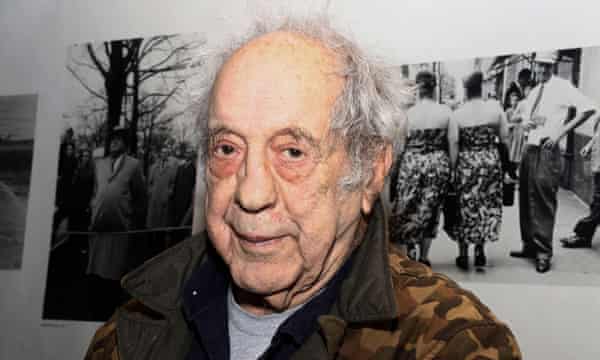What Camera Does Robert Frank Use
Robert Frank, the American artist whose photographs captured the lives of everyday people and influenced a generation with his raw and evocative style, has died aged 94.
The Swiss-born lensman's seminal book The Americans, which had an introduction from Jack Kerouac, beat generation author of On the Road, helped to alter the direction of photography with its 83 pictures rejecting many conventions of the art grade upward to that point.

Shot on a Leica 35mm photographic camera, the black-and-white images are considered Frank's masterwork and focused on figures from the overlooked margins of American life – from teenage couples and factory workers to bikers. Dubbed the "Manet of the new photography" past the New Yorker critic Janet Malcolm, Frank was considered the father of "the snapshot aesthetic", which captures a spontaneous moment taken on the fly.
Culled from a drove of around 28,000 pictures, The Americans would influence artists including Jeff Wall, Mary Ellen Marking and Ed Ruscha, who said seeing the book every bit a young man was "a stunning, ground-trembling feel" that inspired him to brand his own art. "I was tired of romanticism," Frank said of The Americans, "I wanted to present what I saw, pure and uncomplicated."
That pursuit of purity and simplicity helped Frank find what Sean O'Hagan described every bit "the chasm between the American dream and the everyday reality", with Kerouac saying in his introduction to the U.s. edition of the book, which was released in 1959, that Frank had "sucked a sad poem out of America" with the 83 images.
Sarah Greenough, senior curator of photography at the National Gallery of Art in Washington – who compiled a major exhibition defended to Frank in 2008 – said the photographs revealed a people "who were plagued by racism", "ill-served past their politicians", and also rendered "increasingly numb by the rise culture of consumerism". "But it'due south also important to betoken out that he found new areas of dazzler in those elementary, disregarded corners of American life," she added. "In diners, or on the street. He pioneered a whole new subject matter that we [now] ascertain as icons: cars, jukeboxes, even the road itself."
As well as Frank'southward style challenging the rules of photography which had been solidified by the likes of Henri Cartier-Bresson, Frank was also set on challenging the American institution. "My female parent asked me, 'Why practice you always take pictures of poor people?' Frank told the New York Times. "It wasn't true, but my sympathies were with people who struggled. There was also my mistrust of people who made the rules."
Frank'south style was widely credited as opening the door for other photographers such as Diane Arbus, whose work was exhibited at the hugely influential New Documents exhibition at MoMA in 1969 aslope at-the-time upwards-and-coming artists Lee Friedlander and Garry Winogrand.
In the 60s and 70s Frank would become a countercultural effigy and establish himself as an avant-garde filmmaker. New York Times flick critic Manohla Dargis called Frank "i of the most important and influential American independent filmmakers of the last half-century" and his brusk-form films featured Jack Kerouac, Allen Ginsberg and Alice Neel.
After being commissioned to take cover photography for Exile on Main Street, Frank went on to make Cocksucker Blues, a documentary well-nigh the Rolling Stones' 1972 tour of America, which the band sued him for in society to prevent its release. Described equally "an ambient Stones movie" information technology showed the band and groupies involved in drug taking and grouping sex. Information technology was shelved in favour of another documentary of the 1972 bout, titled Ladies and Gentlemen: The Rolling Stones.
In the same yr Frank released Lines of My Paw, a volume which signalled the artist's move to more autobiographical work that could as well exist seen in the 1988 film, Candy Mountain, a road movie directed with Rudy Wurlitzer.
Lou Reed, another musician, wrote nearly how much he admired Frank'south work in The Lines of My Hand, in 2004. "To wish for the crazy times one concluding time and freeze information technology in the memory of a camera is the to the lowest degree a dandy artist tin do," he wrote. "Robert Frank is a great democrat. We're all in these photos. Paint dripping from a mirror like claret."
There was tragedy in Frank'due south personal life: beginning his daughter Andrea, was killed, aged 20, in a plane crash in Guatemala in 1974, and 20 years later his son Pablo took his own life in 1994 later suffering with schizophrenia. The artist June Leafage, his wife, survives him.
"The kind of photography I did is gone. It's old," Frank told the Guardian in 2004. "In that location'south no point in it whatsoever more for me, and I get no satisfaction from trying to do it. At that place are also many pictures now. Information technology'south overwhelming."
Source: https://www.theguardian.com/artanddesign/2019/sep/10/robert-frank-american-photographer-dies-aged-94-the-americans-jack-kerouac-photography
Posted by: biondohuriturnar.blogspot.com


0 Response to "What Camera Does Robert Frank Use"
Post a Comment